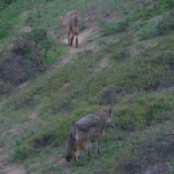Right now it’s mating season for coyotes. This is a once-a-year event, and actually distinguishes coyotes from dogs who have a twice-a-year reproductive cycle. Here is a short summary of the process.
An unattached female usually has several suitors, and it’s the female who then chooses among them: see Coyote Courtship by Walkaboutlou — in this story, the fella who brings her a gift of a rabbit is the one who wins her!! Then, usually, the pair remain together for life, but not always! See “Till Death Do Us Part?“.
In most instances, when the female is in heat, the male will closely and carefully guard her and stay with her. The earliest I’ve seen females reproduce is 2 years of age. The earliest I’ve seen males reproduce is 3 years of age. I’ve heard of them reproducing at a younger age, but I have never seen it myself.
Interestingly, coyote males only produce sperm at this one time of year. Producing that sperm is a two-month long process called spermatogenesis. They, too, become fertile at the same time the females do, and have only a very short window of opportunity in which to ‘perform’. It doesn’t appear that this “system” has limited the number of coyotes around!
Mating in coyotes involves a “tie”, which is how you know that it didn’t happen in the above video — the process was not completed in this video. The tie is where both coyotes become “locked” together for as long as 20 minutes — back end to back end. You can imagine that they are extremely vulnerable during these 20 minutes. In the video above, the male mounts the female, but obviously something isn’t right. He turns around to examine the problem or fix it, then they move out of the range of the camera.
As the time of birth approaches, the female will dig a den or find an appropriate alternative (expand another critter’s hole, find harborage under a rock or fallen tree trunk, etc.). During birth, she’ll want to be left alone, so the male waits or guards the area outside where birthing is taking place — I’ve seen males guard like this for about a week. See The Birthing Rock. During this time, the male often brings food to the female. Then, I’ve seen coyote mothers first emerge from their dens anywhere from one day to almost a week after they give birth.
Pups are born after a 63 day gestation period. I’ve seen as few as one and as many as seven pups born, with an average of 3 or 4. Of that larger litter, only four survived to disperse or move on. Survival rate can be as low as 20% in the wild, but it appears to be higher in urban areas. Pups are raised by both parents. Lactation occurs until about June. As the pups are being weaned they are introduced to regurgitated food from their parents which eventually will be replaced with more and more solid food in the form of dead rodents and then live ones until the pups get the knack of hunting for themselves. However, I have seen a father coyote still regurgitating for his fully yearling pups!!
Pups are kept well hidden and as “secret” as possible until they attain some ability to take care of themselves. Then they hunt together in twos or threes and eventually the youngsters will head off on hunting and explorational forays of their own. They disperse sometime between one and two years of age, usually. In the meantime, for the 1-2 years before dispersal, they live very full and rich family lives, with interactions between them, along with feelings that rival our own.

 Introduction:
Introduction:







